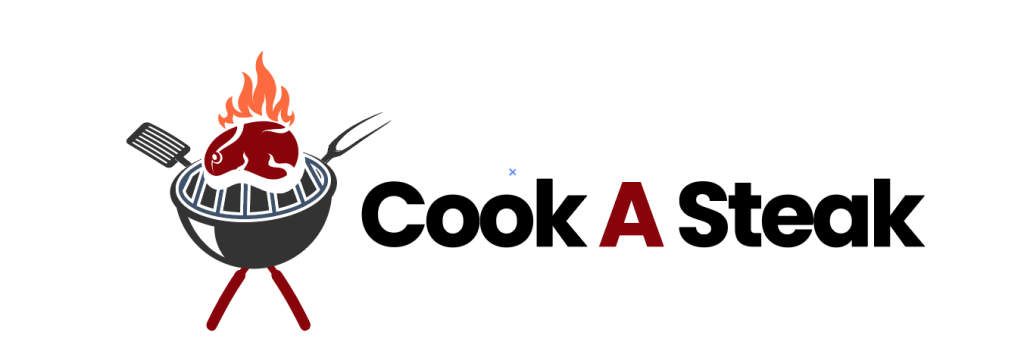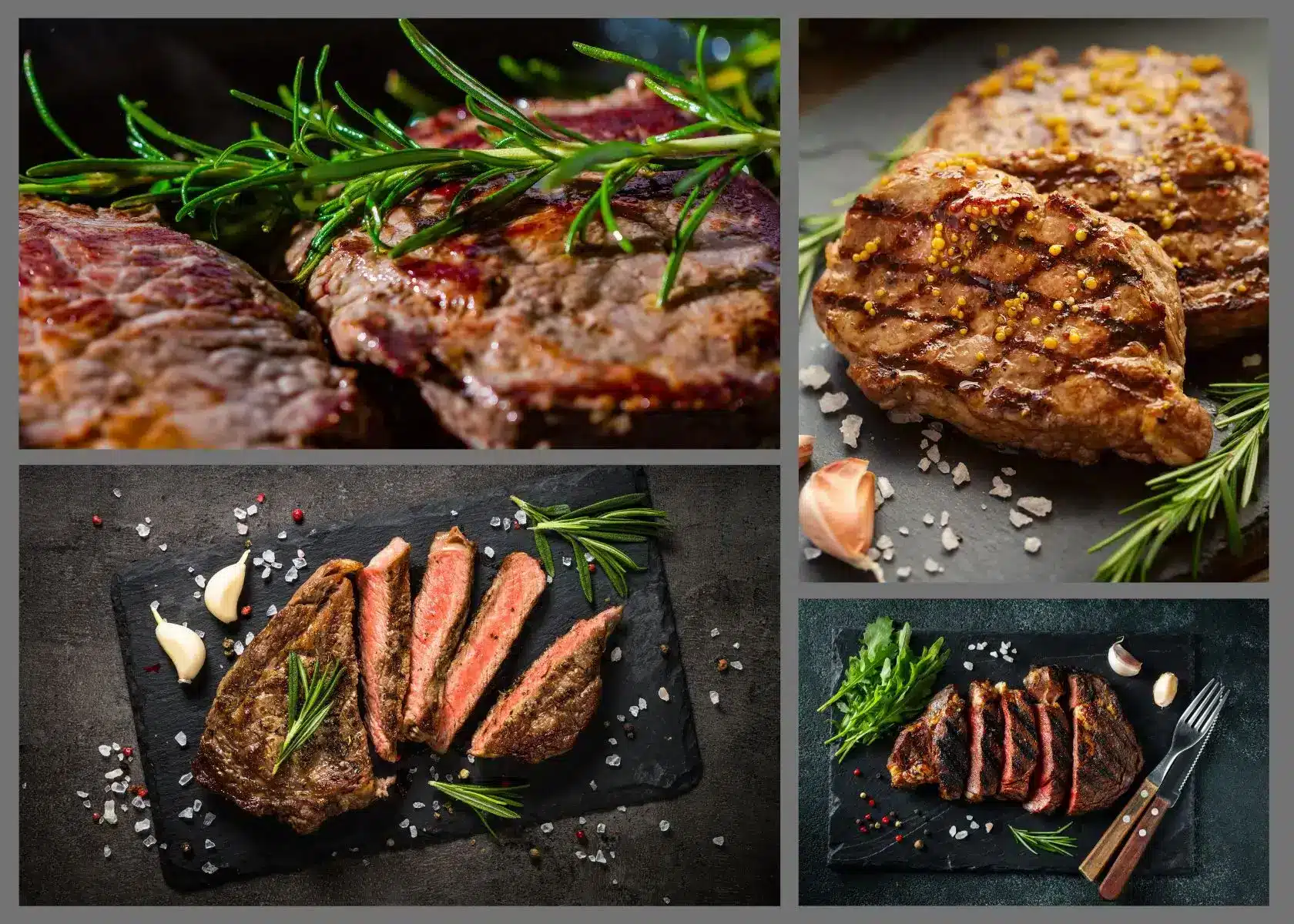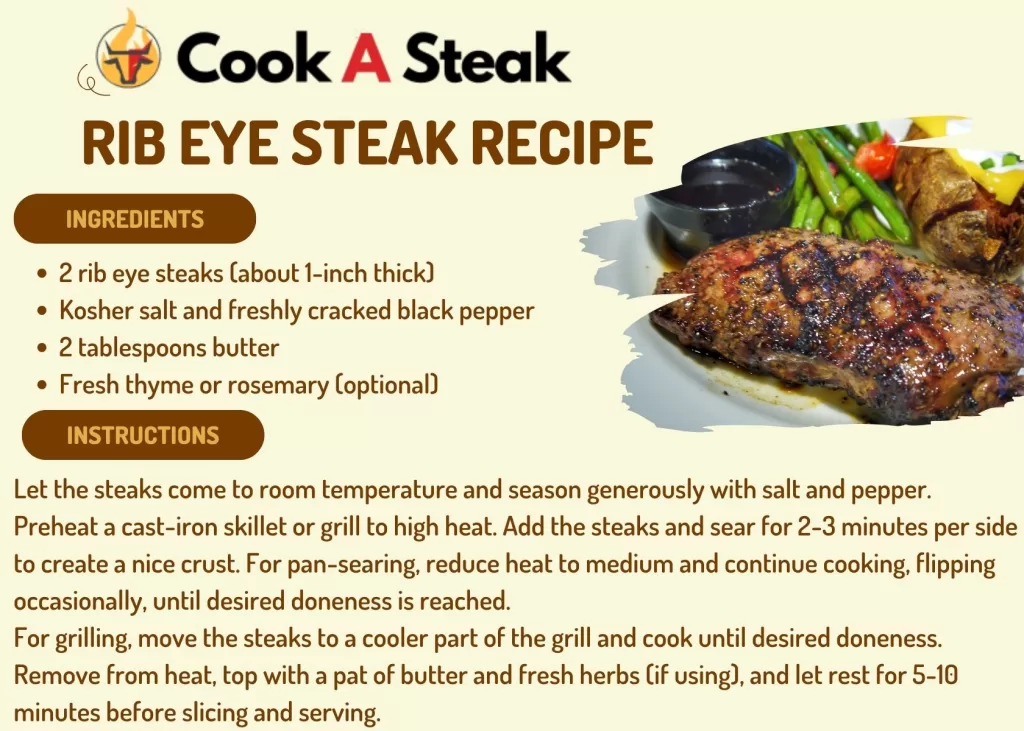There’s something, about a perfectly cooked rib eye steak. This top-tier beef cut is known for its taste, tenderness and marbling, that adds a beefy flavor to every bite. However, getting the steak right requires timing and temperature control. So how do you know how to cook a rib eye?
In this guide, we’ll delve into all the information on cooking times for rib eye steaks using different methods to ensure you can enjoy this delicacy exactly the way you like it each time.
Table of Contents
ToggleUnderstanding Rib Eye
Before we get into cooking specifics it’s important to grasp what makes up a rib eye steak. The rib eye, sometimes spelled as ribeye is a beef steak cut from the ribs of an animal. This part of the meat doesn’t undergo movement resulting in a flavorful cut with fantastic marbling throughout.
Marbling refers to the distribution within the muscle fibers. Is responsible for giving the rib eye its distinct rich and buttery flavor along, with its tender consistency when cooked correctly.
Preparing Your Rib Eye
Achieving steak perfection starts long before you start grilling or preheating your oven. Your first step should be selecting a high-quality rib eye steak from your butcher or grocery store.
When selecting steaks, look for ones that have a hue and an even distribution of marbling throughout the meat. Avoid any steaks that look discolored or have chunks of fat.
After that, it’s important to let your rib eye steak reach room temperature before cooking. This helps ensure that the steak cooks evenly, from the edges to the center. Take the steak out of the fridge. Allow it to sit on the counter for around 30 minutes to an hour before you start cooking.
While the steak is resting you can prepare any seasonings or marinades you want to use. A simple mix of salt and ground black pepper is a traditional choice that lets the natural flavors of the beef stand out. However, feel free to try rubs or marinades to add extra layers of flavor to your ribeye steak.
Cooking Methods
When cooking rib eye steak, you have several options: grilling, pan-searing, and oven-roasting. Each method has its advantages and techniques, so let’s explore them in detail.
Grilling
Grilling is a popular choice for cooking rib eye steaks, as it imparts a delicious smoky flavor and creates a beautiful char on the exterior. There are a few key considerations when grilling rib eye:
- Ribeye on the Grill Time: The grilling time for a rib eye steak will vary depending on the thickness of the steak and your desired doneness level. Generally, plan for about 4-5 minutes per side for a 1-inch thick steak cooked to medium-rare doneness.
- Ribeye Grill Time: You may need to adjust your grill time for thicker steaks. A good rule of thumb is to grill for about 5 minutes per side for a 1 1/2-inch thick steak to achieve medium-rare doneness.
- Achieving the Perfect Crust: To get that coveted char and crust on your rib eye, preheat your grill to high heat (around 500°F) and ensure the grates are clean and well-oiled. Sear the steak for 2-3 minutes per side to create that delicious crust, then move it to a cooler part of the grill to finish cooking to your desired doneness.
Pan Searing
Pan-searing is an excellent option for cooking rib eye steaks indoors or when you don’t have access to a grill. This method allows you to achieve a beautiful sear and crust while retaining the steak’s juiciness.
How to Cook Ribeye Steak in a Pan
To pan-sear your rib eye, you’ll need a heavy-bottomed skillet, preferably cast iron or stainless steel. Preheat the pan over high heat until it’s scorching hot. Add a small amount of oil or butter, just enough to coat the bottom of the pan. Carefully place the steak in the pan and let it sear undisturbed for 2-3 minutes to develop that delicious crust.
How to Cook a Ribeye on the Stove
After the initial sear, flip the steak and continue cooking, using tongs to hold the steak on its side to render some of the fat and get an even browning on the edges. Keep flipping and searing the steak until it reaches your desired doneness.
Getting the Right Sear
For the best sear, ensure your pan is hot enough before adding the steak. You should hear a sizzle when the steak hits the pan, indicating it’s hot enough to create that perfect crust. Don’t overcrowd the pan; this can cause steaming instead of searing.
Oven Roasting
Oven-roasting is a foolproof method for cooking rib eye steaks, especially for thicker cuts or if you’re cooking multiple steaks simultaneously. This method combines searing with gentle, even cooking in the oven.
Oven Temps and Times: For oven-roasting, preheat your oven to 450°F. Sear the steaks in a hot skillet or oven-safe pan until they develop a nice crust, then transfer the pan to the preheated oven. Roast 10-12 minutes for a 1-inch thick steak to reach medium-rare doneness. Adjust the time accordingly for thicker or thinner steaks.
Bringing Steak to Room Temp: As with the other methods, it’s essential to let your rib eye steak come to room temperature before cooking. This helps ensure even cooking from edge to centre.
Using a Meat Thermometer: To ensure you don’t overcook your steak, it’s best to use a reliable meat thermometer. Insert the thermometer into the thickest part of the steak, careful not to touch any bones. For a perfect medium-rare, aim for an internal temperature of 130°F.
Determining Doneness
Speaking of doneness, let’s talk about determining when your rib-eye steak has reached your desired level of doneness. The most accurate way is to use a meat thermometer, but you can also use the touch test method.
Ribeye Medium Rare Temp
For many steak enthusiasts, medium-rare is the gold standard for rib eye steaks. The steak’s interior will be a vibrant pink with a slightly warm, ruby-red center at this level of doneness. The ribeye medium rare temp you’re aiming for is 130°F to 135°F.
Ribeye Steak Temperature
If you prefer your steak cooked a bit more or less, here are the general temperature ranges for each level of doneness:
- Rare: 120°F to 125°F
- Medium-Rare: 130°F to 135°F
- Medium: 140°F to 145°F
- Medium-Well: 150°F to 155°F
- Well-Done: 160°F and above
Using the Touch Test and Thermometers
In addition to using a meat thermometer, you can also use the touch test to estimate doneness. Here’s how it works:
Press the fleshy area between your thumb and index finger on the same hand. This is what a rare steak feels like when pressed.
Now, press the fleshy area below your thumb. This firmer feel is similar to a medium-rare steak.
Finally, gently press the area where the base of your thumb meets your wrist. This firm feel is comparable to a well-done steak.
Of course, using a meat thermometer is the most accurate method, but the touch test can come in handy when you don’t have one on hand.
Resting and Slicing
Once your rib eye steak has reached your desired level of doneness, it’s crucial to let it rest before slicing into it. This resting period allows the juices to redistribute throughout the meat, ensuring a juicier, more flavorful steak.
Letting Steak Rest
Transfer your steak to a clean cutting board or plate and tent it loosely with aluminum foil when it comes off the heat. Let it rest for about 5-10 minutes, depending on the thickness of the steak.
Slicing Against the Grain
After resting, it’s time to slice into your perfectly cooked rib eye. Always slice against the meat grain for the most tender eating experience. The “grain” refers to the direction of the muscle fibers, which you can see running parallel in the steak. Slicing across these fibers shortens them, making each bite more tender and easier to chew.
Recipes and Dishes
Now that you know how to cook rib eye steak to perfection, let’s explore some delicious recipes and dishes that showcase this premium cut of beef.
Best Ribeye Steak Recipe
One of the simplest and most delicious ways to enjoy a rib eye steak is with this classic recipe:
Ingredients
- 2 rib eye steaks (about 1-inch thick)
- Kosher salt and freshly cracked black pepper
- 2 tablespoons butter
- Fresh thyme or rosemary (optional)
Instructions
- Let the steaks come to room temperature and season generously with salt and pepper.
- Preheat a cast-iron skillet or grill to high heat.
- Add the steaks and sear for 2-3 minutes per side to create a nice crust.
- For pan-searing, reduce heat to medium and continue cooking, flipping occasionally, until desired doneness is reached.
- For grilling, move the steaks to a cooler part of the grill and cook until desired doneness.
- Remove from heat, top with a pat of butter and fresh herbs (if using), and let rest for 5-10 minutes before slicing and serving.
Rib Eye Steak Recipe
For a delicious twist on the classic, try this rib eye steak recipe with a flavorful compound butter:
Ingredients
- 2 rib eye steaks (about 1-inch thick)
- Kosher salt and freshly cracked black pepper
- 1/2 cup butter, softened
- 2 cloves garlic, minced
- 2 tablespoons fresh parsley, chopped
- Zest of 1 lemon
Instructions
- Let the steaks come to room temperature and season generously with salt and pepper.
- Mix the softened butter, minced garlic, chopped parsley, and lemon zest in a small bowl until well combined. Set aside.
- Preheat a cast-iron skillet or grill to high heat.
- Cook the steaks as desired (pan-seared or grilled) until they reach your desired doneness.
- Remove from heat, top each steak with a dollop of the compound butter, and let rest for 5-10 minutes before slicing and serving.
Prime Rib Steak Recipe
For a special occasion, try this prime rib steak recipe that’s sure to impress:
Ingredients
- 2 prime rib steaks (about 1 1/2-inch thick)
- Kosher salt and freshly cracked black pepper
- 2 tablespoons butter
- 2 cloves garlic, minced
- 2 sprigs fresh rosemary
- 1/4 cup beef broth or red wine
Instructions
- Let the prime rib steaks come to room temperature and season generously with salt and pepper.
- Preheat your oven to 450°F.
- Melt the butter over high heat in a large oven-safe skillet or cast-iron pan.
- Sear the steaks for 2-3 minutes per side to develop a nice crust.
- Add the minced garlic and fresh rosemary to the pan.
- Transfer the pan to the preheated oven and roast for 12-15 minutes for medium-rare doneness.
- Remove the pan from the oven and transfer the steaks to a cutting board. Tent with foil and let rest.
- Add the beef broth or red wine to the pan, scraping up any browned bits from the bottom. Let the sauce simmer and reduce slightly.
- Slice the prime rib steaks and serve with the pan sauce drizzled over the top.
Rib Eye Recipes
Beyond these classic preparations, there are countless ways to enjoy the rich, beefy flavor of rib eye steak. Here are a few more delicious rib eye recipes to try:
- Rib Eye with Chimichurri Sauce
- Grilled Rib Eye with Garlic Butter
- Beef Rib Eye Fajitas
- Rib Eye Steak Salad with Blue Cheese
- Beef Rib Eye Steak with Mushroom Sauce
Beef Rib Eye Steak Recipe
And if you’re looking for even more inspiration, here are some additional best beef rib eye steak recipes to explore:
- Grilled Rib Eye with Balsamic Glaze
- Rib Eye Steak with Roasted Garlic Butter
- Beef Rib Eye with Horseradish Cream Sauce
- Cajun-Spiced Rib Eye Steaks
- Bacon-Wrapped Rib Eye Filets
No matter which recipe you choose, the key to success is following the proper cooking times and temperatures to ensure your rib eye steak is cooked to perfection.
Tips and Tricks
As you embark on your rib eye steak cooking adventures, here are some additional tips and tricks to keep in mind:
How Long to Cook Rib eye on Stove
When pan-searing rib eye steaks on the stove, it’s essential to strike the right balance between searing and overcooking. As a general guideline, plan for the following cook times:
- 1-inch thick steak: 4-5 minutes per side for medium-rare
- 1 1/2-inch thick steak: 6-7 minutes per side for medium-rare
Remember, these are just estimates, and actual cooking times may vary based on your stovetop’s heat output and the specific doneness you prefer.
Best Way to Cook a Ribeye Steak
While there’s no single “best” way to cook a rib eye steak, many chefs and steak enthusiasts swear by the reverse-sear method. This technique involves:
- Slow roast the steak in the oven at a low temperature (around 250°F) until it reaches an internal temperature of 10-15 degrees below your desired doneness.
- Remove the steak from the oven and let it rest for 5-10 minutes.
- Searing the steak over high heat (on the grill, in a cast-iron skillet, or using a torch) creates a delicious crust on the outside.
The reverse-sear method allows you to achieve an evenly cooked interior with a perfect crust, all while minimizing the risk of overcooking.
Using Cast Iron or Stainless Steel
When pan-searing rib eye steaks, it’s best to use a heavy-bottomed skillet of cast iron or stainless steel. These materials can withstand the high heat needed for searing without warping or damaging the pan. Avoid non-stick pans, as the coating can break down at the high temperatures required for searing.
Basting with Butter/Herbs
For an extra flavour boost and a deliciously crispy crust, try basting your rib eye steak with butter and fresh herbs as it cooks. Let a few tablespoons of butter melt in the pan, then use a spoon to continuously baste the melted butter over the top of the steak as it cooks. Add fresh thyme, rosemary, or garlic to the butter for an aromatic twist.
Conclusion
Achieving steak perfection with rib eye is all about mastering the art of cooking times and temperatures. Whether you prefer your steak rare, medium-rare, or well-done, following the guidelines in this comprehensive guide will help you unlock the full potential of this premium cut of beef.
Remember, the key is to let your rib eye come to room temperature before cooking, use a reliable meat thermometer, and allow for proper resting times. With practice and attention to detail, you can consistently produce juicy, flavorful rib eye steaks that will have your friends and family raving.
Rib eye is a versatile cut for various cooking methods and flavor combinations. From classic preparations to creative twists, the possibilities are endless. So fire up the grill, preheat the oven, grab your trusty cast-iron skillet, and get ready to experience the ultimate beefy indulgence.
After all, there’s nothing like gathering around the table with loved ones and savoring a perfectly cooked rib eye steak. It’s a moment of pure culinary bliss that brings people together and creates lasting memories. So, master the art of cooking rib eye and enjoy every delicious bite.


